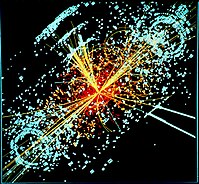
Photo from wikipedia
We study hidden-sector particles at past (CERN-Hamburg-Amsterdam-Rome-Moscow Collaboration and NuCal), present (NA62, SeaQuest, and DarkQuest), and future (LongQuest) experiments at the high-energy intensity frontier. We focus on exploring the minimal… Click to show full abstract
We study hidden-sector particles at past (CERN-Hamburg-Amsterdam-Rome-Moscow Collaboration and NuCal), present (NA62, SeaQuest, and DarkQuest), and future (LongQuest) experiments at the high-energy intensity frontier. We focus on exploring the minimal vector portal and the next-to-minimal models in which the productions and decays are decoupled. These next-to-minimal models have mostly been devised to explain experimental anomalies while avoiding existing constraints. We demonstrate that proton fixed-target experiments provide one of the most powerful probes for the MeV to few GeV mass range of these models, using inelastic dark matter (iDM) as an example. We consider an iDM model with a small mass splitting that yields the observed dark matter relic abundance, and a scenario with a sizable mass splitting that can also explain the muon g-2 anomaly. We set strong limits based on the CERN-Hamburg-Amsterdam-Rome-Moscow Collaboration and NuCal experiments, which come close to excluding iDM as a full-abundance thermal dark matter candidate in the MeV to GeV mass range. We also make projections based on NA62, SeaQuest, and DarkQuest and update the constraints of the minimal dark photon parameter space. We find that NuCal sets the only existing constraint in ε∼10^{-8}-10^{-4} regime, reaching ∼800 MeV in dark photon mass due to the resonant enhancement of proton bremsstrahlung production. These studies also motivate LongQuest, a three-stage retooling of the SeaQuest experiment with short (≲5 m), medium (∼5 m), and long (≳35 m) baseline tracking stations and detectors as a multipurpose machine to explore new physics.
Journal Title: Physical review letters
Year Published: 2021
Link to full text (if available)
Share on Social Media: Sign Up to like & get
recommendations!